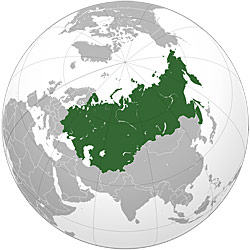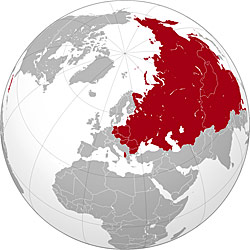
Unit 5: Crisis and Change
Lesson H: From Hot to Cold War
Activity 3: Influence in the Two-Sided Cold War
After World War II, Stalin sought to create a buffer zone of Eastern European satellite states loyal to the U.S.S.R. partially to protect the country from invasion.
Directions: Compare the size of the U.S.S.R. after World War II to the extent of the country's influence as of 1960 using the two maps.

The U.S.S.R. After World War II [1]

Extent of the U.S.S.R.'s Influence in 1960 [2]
Stalin also spread communism by helping local communist parties in these occupied countries come to power. Initially, the U.S.S.R. maintained control behind the "Iron Curtain" through troops, security police, and diplomatic service. The U.S.S.R. established unequal trade agreements with these countries that provided the U.S.S.R. with access to otherwise unavailable valuable resources.
The U.S.S.R.'s actions in Eastern Europe provoked Western hostility, but, short of going to war, the U.S. could not do anything to oppose the consolidation of Soviet authority in the region.
The U.S. and like-minded Western countries did have better luck in halting Soviet expansion in some cases. The United States and its allies feared that if one country fell to communism, then the next country would fall. This was known as the domino theory. A goal of United States foreign policy during the Cold War was to prevent countries from turning to communism.
In 1955, at the Bandung Conference in Indonesia, "Third World" governments of emerging countries of Asia, Africa, and Latin America rejected the pressure to choose sides in the East-West competition and resolved to stay out of the Cold War. Consensus at this conference led to the creation of the Belgrade-headquartered Non-Aligned Movement in 1961.
Directions: View the world map below to see how the competition between the U.S.S.R. and the U.S. and their respective foreign policy decisions played a role in determining which countries around the world would align with which political ideology. Use the Student Resource: Influence in the Two-Sided Cold War to identify which superpower influenced each country. Take notes on important points.
![]() Download the Student Resource: Influence in the Two-Sided Cold War (doc).
Download the Student Resource: Influence in the Two-Sided Cold War (doc).
Written Activity - Notebook
In your notebook, respond to the following questions:
- Are countries like the U.S. and U.S.S.R. (and France and China, etc.) justified in their involvement in the affairs of other new or less powerful countries? Why or why not?
- What is the primary motivation of these countries?
Page Notes:
[1] Source: This image from http://en.wikipedia.org/wiki/File:Union_of_Soviet_Socialist_Republics_(orthographic_projection).svg is licensed under Creative Commons Attribution-Share Alike 3.0 Unported license. Attribution: Ssolbergj.
[2] Source: This image from http://en.wikipedia.org/wiki/File:Soviet_empire_1960.png is his file is licensed under the Creative Commons Attribution-Share Alike 3.0 Unported, 2.5 Generic, 2.0 Generic and 1.0 Generic license. Attribution: MaGioZal.


